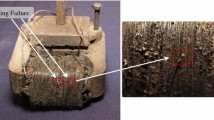Abstract
Fractional horsepower motors are used to power exhaust fans such as those found in bathrooms and oven hoods. There was an increase in fires attributed to these motors shortly after the year 2000. Still, many argue that these motors cannot cause fires because they contain a thermal cutoff (TCO) unit that shuts off electrical current when the TCO reaches a specific temperature. In this paper we describe an unsafe failure mode that can occur after extended use. As fans age, the bearings wear out, resulting in heating of the coil wires. Excessive heating results in break down of the wire insulation, which can lead to a short between wires and create an autotransformer configuration. An autotransformer can support high current in only part of the wiring, resulting in resistive heating sufficient for ignition. With the low thermal conductivity of the coil (\(0.0162\,W/(\hbox {cm}\,{^{\circ }}\hbox {C})\)) and the poor performance of the TCO (no cutoff up to \(260{^{\circ }}\hbox {C}\)), a large temperature gradient is possible. The gradient allows for ignition in one part of the motor without activating the TCO. We experimentally validated the proposed mechanism in an isolated motor and a complete fan assembly resulting in ignition after 18 s and 23 s. The assembled fan burned for more than 6 minutes before we extinguished the flames for safety reasons. Our results are consistent with field results from actual fires.















Similar content being viewed by others
References
Hall Jr JR (2013) Home electrical fires. Technical report, National Fire Protection Association
Hall Jr JR (2012) Home fires involving air condition, fans or related equipment. Technical report, National Fire Protection Association
MacLeod K (2015) 7 killed in Lowell fire remembered on anniversary. CBS Boston Online, July 2015
Elder AT, Squires T, Busuttil A (1996) Fire fatalities in elderly people. Age Ageing 25(3):214–216
Warda L, Tenenbein M, Moffatt MEK (1999) House fire injury prevention update. Part I. A review of risk factors for fatal and non-fatal house fire injury. Inj Prev 5(2):145–150
Delonno A (2004) All controls are not created equal: thermal cutoffs require extra consideration. Prof Saf 49(10):47, 10
Lewis KH, Scheiff S, Challman T, Murphy D, Thoresen A (2015) Ventilation fan fires: overheated windings lead to failed thermal limit switch. Fire Technol 51(5):1033–1050
Wise S, Cardwell R (2015) The warning firefighters want you to hear about bathroom exhaust fans. CBS WTVR Online, February 2015.
Monfort A (2015) Firefighters warn about bathroom fan fire danger. NBC12 Online, February 2015.
Lawrie RJ (ed) (1987) Electric motor manual. McGraw-Hill Book Company, New York
Geiger, GH, Poirier, DR (1973) Transport phenomenon in metallurgy. Addison-Wesley, Reading
Byron BR, Stewart WE, Lightfoot EN (1960) Transport phenomena. Wiley, New York
NFPA 921: Guide for fire and explosion investigations. Technical report, National Fire Protection Association (2014)
Davis JR (1998) Metals handbook, 2nd Ed. ASM International, Materials Park, OH
Higgins RA (2010) Materials for engineers and technicians, 5th Ed. Elsevier, Burlington, MA
Drysdale D (1998) An introduction to fire dynamics. Wiley, New York
Ganguli TK (2005) Transformers chapter introduction, McGraw-Hill, New York, pp 1–5.
Winders Jr JJ (2002) Power transformers. Marcel Dekker Inc, New York
Singh RK (2005) Transformers chapter principles of transformers. McGraw-Hill, New York, pp 6–33
Feinberg R (ed) (1979) Modern power transformer practice. Wiley, New York
Rawat BL (2005) Transformers chapter transformer protection. McGraw-Hill, New York, pp 456–465
National Electrical Manufacturers Association (NEMA) MG 1-2016 Motors and Generators
Menges G, Osswald TA (2013) Material science of polymers for engineers. 3 edn. Hanser, Munich
Brancato EL (1992) Estimation of lifetime expectancies of motors. IEEE Electr Insul Mag, 8(3):5–13
DeHaan JD (2002) Kirk’s fire investigation. 5th edn. Prentice Hall, Englewood Cliffs
Lee A (2017) CPSC staff assessment on eutectic-type thermal-cutoff fuse failures in shaded-pole motors used in exhaust fans. Consumer Product Safety Commission, Directorate for Engineering Sciences
Funding
Although many of the tests reported herein were funded as part of specific fire investigations, production of this paper was funded by the authors in the interest of public safety.
Author information
Authors and Affiliations
Corresponding author
Rights and permissions
About this article
Cite this article
Haslam, B., Galler, D. & Eagar, T.W. Failure of Fractional Horsepower Ventilation Fan Motors. Fire Technol 54, 967–994 (2018). https://doi.org/10.1007/s10694-018-0720-4
Received:
Accepted:
Published:
Issue Date:
DOI: https://doi.org/10.1007/s10694-018-0720-4










